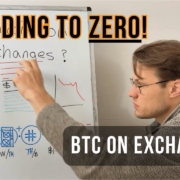Low Fees: Bitcoin’s Silent Killer?! Or Not? | Hashpower Academy
Are low fees and shrinking subsidies killing Bitcoin? Think again! In this Bitcoin Education drop, we tackle the fear: blockchain use is low, subsidies are fading—yet BTC’s value SOARS. How? We dive into Bitcoin’s energy economics in a post-dollar world. Miners settle electricity on-chain, sparking endless economic activity—mutual incentives that stabilize grids and monetize the network. More power, more value, less fiat noise. Watch to see why holders win big as Bitcoin rewrites the rules!
Financial Disclaimer:
This video serves educational and informational purposes only and should not be construed as financial advice or investment recommendation. The views expressed are those of the presenter and do not represent Hashpower Academy’s official stance. Information is provided ‘as is’ without warranties, express or implied, as to its accuracy or completeness. Engaging with Bitcoin involves high risk, including potential financial loss, market volatility, and energy costs, and is suitable only for those who can bear these risks. Always conduct your own research and consult with a qualified financial or technical advisor before making decisions related to Bitcoin.
#Bitcoin
#BitcoinEducation
#Crypto
#BTC
#LowFees
#SubsidyDecline
#BitcoinValue
#Mining
#EnergyEconomics
#Blockchain
#GridStability
#BitcoinMining
#CryptoEducation
#PostDollar
#BTCValue
#EnergyMarkets
#BitcoinNetwork
#CryptoEconomics
#LearnBitcoin
#BitcoinFuture
Video Transcript:
hello there and welcome to the HashPower Academy my name is Jake Scandlin i’m the lead educator here at the academy and this is a place for you to learn anything and everything to do with Bitcoin and its underlying network of technologies and commodities so the topic of today’s video is going to look at the decline in subsidy inevitably every four years the h havinging but also the amount of fees per block is really low and that is a concern to some people that the security budget the amount of bitcoin being distributed say per day in 144 blocks that’s the security budget that’s what the miners are being paid to protect the network instead of attack it and all of these sorts of pieces come into the underlying energy conversation of Bitcoin because Bitcoin is produced from electricity it’s its native commodity underneath that electricity is converted into compute converted into Bitcoin a database of money digital hard on the internet with an electrical cost from the real world to produce and these are very important pieces to this discussion because well the miners are the ones protecting the Bitcoin network and adding Bitcoin blocks to the chain now right now the difficulty of Bitcoin that is how hard it is to mine is 113.76 trillion and what you can do with the current difficulty well you can multiply it by this constant and I’ll talk about this in another video but what this gives you is the network hash rate and this is very important because the the Bitcoin software is trying to make sure that blocks are every 10 minutes it’s regulating time by understanding how much compute is issuing space so to speak with an underlying energy cost so every time you see the difficulty measured in t you can just multiply it by 7.15 and you’ll get the average network hash rate now that we’ve got this network hash rate we can multiply it by say a mining machine with an efficiency of 20 jewels per terahash um which if you multiply that out that is 16.2 16,286 megaww so that is network energy at a conversion rate of 20 jewels per tash network hash rate and the network revenue and why did we use the diff why did we use the difficulty uh metric because it is the signal amongst all of the noise the fiat price of Bitcoin is always changing fees are always changing the efficiency of Bitcoin mining hardware is always changing to the downside because lower lower jewels per terahash means less energy to produce more hash rate output uh the grid is always fluctuating in its energy usage and that continual expansion of energy and compute underneath a constrained quantity of 21 million but at a pricing system of the rate of Bitcoin being mined per day or per hour these are all very important now here’s the other thing if you want to price this um against a bitcoin we can say well 450 bitcoin is about well 450 bitcoin per day 144 blocks divide them both by 25 and you get six blocks per hour once every 10 minutes approximate and that is uh 18.75 bitcoin per hour so 16,000 megawws of power is earning 18.5 bitcoin per hour so if you divide this out the current uh exchange rate I’m going to put that there the current exchange rate of one bitcoin to energy right now and we’ve discussed this in other videos is 868 megawws per one bitcoin and you can multiply 868 by 50 $50 a megawatt and there you go you get your dollar production cost but we’re not about the dollar in this discussion everything I’ve shown you is raw uh units and maths of Bitcoin related to electricity now this is where it gets interesting the discussion of today’s video the amount of fees per block is fluctuating subsidy we’ve got it guaranteed per block distributing out over the next 100 years until there’s zero subsidy so fees inevitably take over at some point but these are all moving these are all moving the difficulty adjustment is the software itself defining its constant for the next two weeks and so what happens uh when this the next h havinging comes along now we have let’s just say that hash rate doesn’t change but hash rate has gone up hundreds of percent over the last couple years so to assume that there’s going to be more energy and more compute being priced against an even smaller quantity of bitcoin but for this example let’s just say that the network doesn’t increase which would actually increase these values even more well what you would get is a pricing system of double half the amount of Bitcoin priced against the same amount of energy if you divide uh this figure by what was it uh it’s getting smaller now 9.375 bitcoin per hour then one bitcoin is priced against 1700 megaww so that’s 1.7 million kilowatt hours that’s how much uh electricity you can buy from miners at this efficiency rate and we can keep going smaller with every haring what I’m trying to explain here is that the exchange rate of Bitcoin to electricity means that when there is no fees and just subsidy your Bitcoin allows you to buy more power because every time there’s low fees in blocks the value of your Bitcoin is higher it’s a very paradoxical way to understand Bitcoin and this is because again 450 Bitcoin is being priced across an day which divides down to 18.75 Bitcoin per hour and you divide the amount of energy in the network which is priced against this Bitcoin at a rate of 868 against 225 Bitcoin cut it in half it means for the mining side uh my energy bill my energy rate the energy usage is the same but the amount of Bitcoin I get cuts in half you’ve got to put yourself in the mindset of the person holding the Bitcoin that could potentially buy that energy flip it the other way round you’re holding a Bitcoin and now the rate in which Bitcoin is distributed um per energy consumer cuts in half it means that miner needs to consume twice as much energy for that same rate of Bitcoin and this is important in the context of Bitcoin’s energy economics because if uh the exchange rate of Bitcoin to electricity is continually being well increased to the buyer the holder what it basically means is Bitcoin in the future is a productive commodity if you have a use for electricity and you have some form of intermittent use of energy the best thing you can hold is Bitcoin because it continually gains in value in the terms of the amount of electricity that can be purchased from miners local to you because the physical constraint here is that it’s local energy being priced to global finance inversely uh if you are the producer of Bitcoin you’re consuming energy as a cost to capture some of this daily Bitcoin if the amount of fees were to massively increase uh this raises that energy price that you would now be buying less energy per Bitcoin again it’s a very paradoxical way to think of it and this is essentially what every bull market is in dollar terms the well last cycle the the amount of Bitcoin that you would earn per kilowatt went up to like 20 to 30 to 40 cents of Bitcoin per kilowatt and so the rate in which they would sell that power back to the grid is up to 40 cents which is very high and so from a dollar fiat and debt perspective Bitcoin replaces interest rates with debt money for energy prices with energy money and as I’ve as I’ve said earlier on none of this is to do with the dollar this is completely a mathematical connection of this amount of bitcoin per day divide it by 24 multiply it by the hash rate sorry difficulty um defines the hash rate from uh this constant and then from that amount of hash rate you can multiply it to understand the amount of energy in the system if you are on the mining side of this uh you would use your own conversion rate so if you have your own mining machines you would understand the rate in which you’re willing to sell energy but I’ve used an average because once you start looking at each individual miner’s exchange rate of Bitcoin to electricity a network collective uh value for their energy but a local efficiency conversion rate for their energy you think of it in the context of the amount of uh bitcoin that they will earn for their energy cost but if they have a more efficient machine they earn a greater quantity so the price in terms of energy that they’ll exchange for their bitcoin or vice versa is higher inversely uh energy producers get more older more ine well less less efficient machines and those less efficient machines enable them to uh produce Bitcoin at a lower exchange rate which means that uh if the most expensive most efficient machines are closer to energy consumption and the less efficient machines are closer to production it creates a standardized price for energy which aligns perfectly to our energy system the closer to the producer you are the cheaper the energy the closer to the consumer say the city the more expensive the energy so the energy economics behind Bitcoin are so fascinating and I think I probably probably need to write an entire course that really breaks this down piece by piece but this is to just give you an understanding that as the subsidy cuts in half the amount of uh megawws per per bitcoin increases as you decline the subsidy you increase the purchasing power of Bitcoin and this is actually why every time there’s a hinging event Bitcoin may have a dip but it goes back up to the price in dollars that the new production rate is because if the production floor say in the 2020 hing was I think it it dropped all the way down to 3 to 4,000 but the that was the production floor about 4,000 and the Haring came along and now the production cost is 8,000 so we knew in a couple months time that the new production cost would be $8,000 and if the price was sitting at 4,000 you knew that in a couple months it was going to cost you more than $8,000 to produce a Bitcoin while the price today was four time to buy you’re buying at half the rate that the future miners will be producing at and so that price if you remember just after COVID the price crashed down to 4,000 and shot straight back up to about 8,000 and then stabilized and this is this essentially demonstrates that underneath the price there is this energy economics that few people actually understand unless they delve into the mining side of things i think I’m going to stop it there the overall approach here in the sort of summary is everything to do with the energy is the noise of the network everything to do with fiat and fees they are fluctuating and variable bitcoin’s code its software in of itself has a constant in terms of its conversion to hash rate but also the difficulty adjustment is looking back 2016 blocks at the rate of how quickly in time that they are mined and understanding how much space is entering in the digital world so to speak in terms of hash rate when you take that local conversion you can multiply the hash rate and exash by the efficiency of your machine or the average of the network to understand roughly how much energy is in the Bitcoin network it’s multiple gigawatt and as you repric all this energy against a smaller quantity of Bitcoin you increase the purchasing power the value in terms of electrons that the Bitcoin can purchase now if this sustains and it’s not efficient for miners we could see hash rates switch off but what that does is repric the energy against um well less well there’s less energy priced against more Bitcoin so miners that are online start earning more because the the pie of Bitcoin starts distributing to a smaller quantity so that’s when it’s more incentivized to mine inversely you can understand that if some of this electricity gets switched off it’s using the block rewards as a pricing system but earning that income externally so if you sell to the local grid there’s some form of other aspect but this is where it gets really interesting i believe the best survival mechanism for Bitcoin is to collapse the mirror image which is now we’re showing it here as a circular economy i haven’t added time to these units other than hash rate but this pricing system of bitcoin to energy the conversion efficiency of machines and the amount of bitcoin hash rate is earning you’ve got this energy space and time sort of conundrum of how it all fits together these three are the physical components and these three are the digital aspects and what you can essentially take away from this is the blockchain and the electrical grid are essentially mirror images of each other in digital and physical form and the way Bitcoin stays alive is this circular system of connecting these two worlds and I suppose the best thing that could happen to Bitcoin to stimulate economic activity is because it has a mathematical connection to electricity that and and if the blockchain is a mirror image uh to the electrical grid why don’t we have electricity as a standardized settlement in Bitcoin blocks that they’ve got computers across every grid on the planet and you could essentially use those computers to communicate with the blockchain for its control actions of switching on and off to stabilize grids because if the pricing of energy was defined in Bitcoin blocks you now have Bitcoin’s intrinsic commodity on the blockchain in terms of its trade and settlement and its stability of grids being the very thing that monetizes Bitcoin from external buyers and sellers producing energy to produce compute to produce Bitcoin so hope this was an interesting video it might have gone a bit weird and wonderful but um I I really do think I really do think about these things and um the energy economics of Bitcoin is an entire world that um well developing developing a few things in this direction that I believe that will be intrinsically valuable to the network and the prosperity of it in the future thank you for listening hope you enjoy this video wasn’t too perfect but oh well see you in the next one







![🚨 3 SHOCKING Truths about your Bank MONEY! 💰 | 🚨 3 SHOCKING Truths about your Bank MONEY! 💰 | Hashpower Academy [🍊💊]](https://hashpower.academy/wp-content/uploads/2025/07/3-SHOCKING-Truths-about-your-Bank-MONEY-Hashpower-Academy-180x180.jpg)






Leave a Reply
Want to join the discussion?Feel free to contribute!